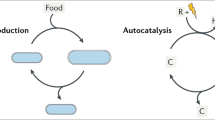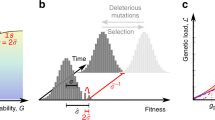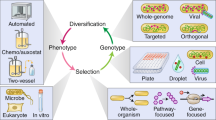Abstract
Why infer evolution when you can watch it happen in real time? This is the basic premise of using populations of fast-replicating microorganisms in test tubes to study evolution. The approach, known as experimental evolution, has provided a way of testing many of the key hypotheses that arose from the modern evolutionary synthesis. However, details of the unnatural histories of microorganisms in test tubes can be extrapolated only so far. Potential future directions for the approach include studying microbial evolution for its own sake under the most natural conditions possible in the test tube, and testing some qualitative theories of genome evolution.
This is a preview of subscription content, access via your institution
Access options
Subscribe to this journal
Receive 51 print issues and online access
$199.00 per year
only $3.90 per issue
Buy this article
- Purchase on Springer Link
- Instant access to full article PDF
Prices may be subject to local taxes which are calculated during checkout




Similar content being viewed by others
References
Darwin, C. On the Origin of Species by Means of Natural Selection, or the Preservation of Favoured Races in the Struggle for Life (John Murray, 1859).
Bell, G. Selection: The Mechanism of Evolution (Oxford Univ. Press, 2007).
Lenski, R. E., Rose, M. R., Simpson, S. C. & Tadler, S. C. Long term experimental evolution in Escherichia coli. 1. Adaptation and divergence during 2000 generations. Am. Nat. 138, 1315–1341 (1991). This paper provided the first demonstration of long-term evolutionary dynamics in real time.
Dallinger, W. On the life-history of a minute septic organism: with an account of experiments made to determine its thermal death point. Proc. R. Soc. Lond. 27, 332–350 (1878).
Huxley, J. Evolution: The Modern Synthesis (Allen & Unwin, 1942).
Elena, S. F. & Lenski, R. E. Evolution experiments with microorganisms: the dynamics and genetic bases of adaptation. Nature Rev. Genet. 4, 457–469 (2003).
Lenski, R. E. & Travisano, M. Dynamics of adaptation and diversification — a 10,000-generation experiment with bacterial populations. Proc. Natl Acad. Sci. USA 91, 6808–6814 (1994).
Woods, R., Schneider, D., Winkworth, C. L., Riley, M. A. & Lenski, R. E. Tests of parallel molecular evolution in a long-term experiment with Escherichia coli . Proc. Natl Acad. Sci. USA 103, 9107–9112 (2006).
Ostrowski, E. A., Woods, R. J. & Lenski, R. E. The genetic basis of parallel and divergent phenotypic responses in evolving populations of Escherichia coli . Proc. R. Soc. Lond. B 275, 277–284 (2008).
Blount, Z. D. & Grogan, D. W. New insertion sequences of Sulfolobus: functional properties and implications for genome evolution in hyperthermophilic Archaea. Mol. Microbiol. 55, 312–325 (2005).
Goddard, M. R., Godfray, H. C. J. & Burt, A. Sex increases the efficacy of natural selection in experimental yeast populations. Nature 434, 636–640 (2005).
Colegrave, N. Sex releases the speed limit on evolution. Nature 420, 664–666 (2002).
Fisher, R. A. The Genetical Theory of Natural Selection (Oxford Univ. Press, 1930).
Muller, H. J. Some genetic aspects of sex. Am. Nat. 8, 118–138 (1932).
Drake, J. W. Spontaneous mutation. Annu. Rev. Genet. 25, 125–146 (1991).
Giraud, A., Radman, M., Matic, I. & Taddei, F. The rise and fall of mutator bacteria. Curr. Opin. Microbiol. 4, 582–585 (2001).
Taddei, F. et al. Role of mutator alleles in adaptive evolution. Nature 387, 700–702 (1997).
Giraud, A. et al. Costs and benefits of high mutation rates: adaptive evolution of bacteria in the mouse gut. Science 291, 2606–2608 (2001). This paper identifies the selective forces acting on the mutation rate of pathogenic bacteria in vivo.
Sniegowski, P. D., Gerrish, P. J. & Lenski, R. E. Evolution of high mutation rates in experimental populations of E. coli . Nature 387, 703–705 (1997).
Pal, C., Macia, M. D., Oliver, A., Schachar, I. & Buckling, A. Coevolution with viruses drives the evolution of bacterial mutation rates. Nature 450, 1079–1081 (2007).
de Visser, J., Zeyl, C. W., Gerrish, P. J., Blanchard, J. L. & Lenski, R. E. Diminishing returns from mutation supply rate in asexual populations. Science 283, 404–406 (1999).
Gause, G. F. The Struggle for Existence (Williams & Wilkins, 1934).
Rainey, P. B. & Travisano, M. Adaptive radiation in a heterogeneous environment. Nature 394, 69–72 (1998). This paper shows that competition in a spatially variable environment drives the diversification of bacteria into spatial niche specialists.
MacLean, R. C. & Bell, G. Experimental adaptive radiation in Pseudomonas . Am. Nat. 160, 569–581 (2002).
Helling, R. B., Vargas, C. N. & Adams, J. Evolution of Escherichia coli during growth in a constant environment. Genetics 116, 349–358 (1987).
Rosenzweig, R. F., Sharp, R. R., Treves, D. S. & Adams, J. Microbial evolution in a simple unstructured environment — genetic differentiation in Escherichia coli . Genetics 137, 903–917 (1994).
Treves, D. S., Manning, S. & Adams, J. Repeated evolution of an acetate-crossfeeding polymorphism in long-term populations of Escherichia coli. Mol. Biol. Evol. 15, 789–797 (1998).
Elena, S. F. & Lenski, R. E. Long-term experimental evolution in Escherichia coli. VII. Mechanisms maintaining genetic variability within populations. Evolution 51, 1058–1067 (1997).
Rozen, D. E. & Lenski, R. E. Long-term experimental evolution in Escherichia coli. VIII. Dynamics of a balanced polymorphism. Am. Nat. 155, 24–35 (2000).
Novak, M., Pfeiffer, T., Lenski, R. E., Sauer, U. & Bonhoeffer, S. Experimental tests for an evolutionary trade-off between growth rate and yield in E. coli. Am. Nat. 168, 242–251 (2006).
West, S. A., Diggle, S. P., Buckling, A., Gardner, A. & Griffins, A. S. The social lives of microbes. Annu. Rev. Ecol. Evol. Syst. 38, 53–77 (2007).
Crespi, B. J. The evolution of social behavior in microorganisms. Trends Ecol. Evol. 16, 178–183 (2001).
Darwin, C. The Descent of Man, and Selection in Relation to Sex (John Murray, 1871).
Hamilton, W. D. The genetical evolution of social behaviour, I & II. J. Theor. Biol. 7, 1–52 (1964).
Harrison, E. F. & Buckling, A. Hypermutability impedes cooperation in pathogenic bacteria. Curr. Biol. 15, 1968–1971 (2005).
Griffin, A. S., West, S. A. & Buckling, A. Cooperation and competition in pathogenic bacteria. Nature 430, 1024–1027 (2004). This paper disentangles the role of relatedness and kin competition in driving the evolution of cooperation.
Mehdiabadi, N. J. et al. Kin preference in a social microbe. Nature 442, 881–882 (2006).
Thompson, J. N. The Coevolutionary Process (Univ. Chicago Press, 1994).
Hamilton, W. D., Axelrod, R. & Tanese, R. Sexual reproduction as an adaptation to resist parasites. Proc. Natl Acad. Sci. USA 87, 3566–3573 (1990).
Bohannan, B. J. M. & Lenski, R. E. Linking genetic change to community evolution: insights from studies of bacteria and bacteriophage. Ecol. Lett. 3, 362–377 (2000).
Buckling, A. & Rainey, P. B. Antagonistic coevolution between a bacterium and a bacteriophage. Proc. R. Soc. Lond. B 269, 931–936 (2002).
Forde, S. E., Thompson, J. N. & Bohannan, B. J. M. Gene flow reverses an adaptive cline in a coevolving host–parasitoid interaction. Am. Nat. 169, 794–801 (2007).
Chao, L., Levin, B. R. & Stewart, F. M. A complex community in a simple habitat: an experimental study with bacteria and phage. Ecology 58, 369–378 (1977). This paper demonstrates extremely rapid real-time co-evolution between natural enemies, suggesting that co-evolution is a crucial process in ecology and evolution.
Buckling, A. & Rainey, P. B. The role of parasites in sympatric and allopatric diversification. Nature 420, 496–499 (2002).
Modi, R. I. & Adams, J. Coevolution in bacterial-plasmid populations. Evolution 45, 656–667 (1991).
Gratten, J. et al. A localized negative genetic correlation constrains microevolution of coat color in wild sheep. Science 319, 318–320 (2008).
Benmayor, R., Buckling, A., Bonsall, M. B., Brockhurst, M. A. & Hodgson, D. J. The interactive effects of parasites, disturbance, and productivity on experimental adaptive radiations. Evolution 62, 467–477 (2008).
Ochman, H., Lawrence, J. G. & Groisman, E. A. Lateral gene transfer and the nature of bacterial innovation. Nature 405, 299–304 (2000).
Ackermann, M., Stearns, S. C. & Jenal, U. Senescence in a bacterium with asymmetric division. Science 300, 1920 (2003). This was the first demonstration that bacteria can age.
Stewart, E. J., Madden, R., Paul, G. & Taddei, F. Aging and death in an organism that reproduces by morphologically symmetric division. PLoS Biol. 3, 295–300 (2005).
Ackermann, M., Schauerte, A., Stearns, S. C. & Jenal, U. Experimental evolution of aging in a bacterium. BMC Evol. Biol. 7, 126 (2007).
Elena, S. F., Cooper, V. S. & Lenski, R. E. Punctuated evolution caused by selection of rare beneficial mutations. Science 272, 1802–1804 (1996).
Bantinaki, E. et al. Adaptive divergence in experimental populations of Pseudomonas fluorescens. III. Mutational origins of wrinkly spreader diversity. Genetics 176, 441–453 (2007).
Schluter, D. The Ecology of Adaptive Radiations (Oxford Univ. Press, 2000).
Dettman, J. R., Sirjusingh, C., Kohn, L. M. & Anderson, J. B. Incipient speciation by divergent adaptation and antagonistic epistasis in yeast. Nature 447, 585–588 (2007).
Wagner, A. Robustness and Evolvability in Living Systems (Princeton Univ. Press, 2005).
Pal, C. et al. Chance and necessity in the evolution of minimal metabolic networks. Nature 440, 667–670 (2006).
Harrison, R., Papp, B., Pal, C., Oliver, S. G. & Delneri, D. Plasticity of genetic interactions in metabolic networks of yeast. Proc. Natl Acad. Sci. USA 104, 2307–2312 (2007).
Mortlock, R. C. E. Microorganisms as Model Systems for Studying Evolution (Plenum, 1984).
Wichman, H. A., Badgett, M. R., Scott, L. A., Boulianne, C. M. & Bull, J. J. Different trajectories of parallel evolution during viral adaptation. Science 285, 422–424 (1999).
Velicer, G. J. et al. Comprehensive mutation identification in an evolved bacterial cooperator and its cheating ancestor. Proc. Natl Acad. Sci. USA 103, 8107–8112 (2006).
Dunham, M. J. et al. Characteristic genome rearrangements in experimental evolution of Saccharomyces cerevisiae . Proc. Natl Acad. Sci. USA 99, 16144–16149 (2002).
De Vos, D. et al. Study of pyoverdine type and production by Pseudomonas aeruginosa isolated from cystic fibrosis patients: prevalence of type II pyoverdine isolates and accumulation of pyoverdine-negative mutations. Arch. Microbiol. 175, 384–388 (2001).
Smith, E. E. et al. Genetic adaptation by Pseudomonas aeruginosa to the airways of cystic fibrosis patients. Proc. Natl Acad. Sci. USA 103, 8487–8492 (2006).
Meyer, J. M., Neely, A., Stintzi, A., Georges, C. & Holder, I. A. Pyoverdin is essential for virulence of Pseudomonas aeruginosa . Infect. Immun. 64, 518–523 (1996).
Bjarnasholt, T. & Givskov, M. Quorum-sensing blockade as a strategy for enhancing host defences againts bacterial pathogens. Phil. Trans. R. Soc. Lond. B 362, 1212–1223 (2007).
Perron, G. G., Zasloff, M. & Bell, G. Experimental evolution of resistance to an antimicrobial peptide. Proc. R. Soc. Lond. B 273, 251–256 (2006).
Bolotin, A. et al. Complete sequence and comparative genome analysis of the dairy bacterium Streptococcus thermophilus. Nature Biotechnol. 22, 1554–1558 (2004).
Manefield, M., Griffiths, R. I., Leigh, M. B., Fisher, R. & Whiteley, A. S. Functional and compositional comparison of two activated sludge communities remediating coking effluent. Environ. Microbiol. 7, 715–722 (2005).
Levin, B. R. & Bull, J. J. Population and evolutionary dynamics of phage therapy. Nature Rev. Microbiol. 2, 166–173 (2004).
Acknowledgements
We thank the Royal Society and the Leverhulme Trust for funding.
Author information
Authors and Affiliations
Ethics declarations
Competing interests
The authors declare no competing financial interests.
Additional information
Reprints and permissions information is available at http://www.nature.com/reprints.
Correspondence should be addressed to A.B. (angus.buckling@zoo.ox.ac.uk).
Rights and permissions
About this article
Cite this article
Buckling, A., Craig Maclean, R., Brockhurst, M. et al. The Beagle in a bottle. Nature 457, 824–829 (2009). https://doi.org/10.1038/nature07892
Published:
Issue Date:
DOI: https://doi.org/10.1038/nature07892
This article is cited by
-
Localized coevolution between microbial predator and prey alters community-wide gene expression and ecosystem function
The ISME Journal (2023)
-
Miniature worlds
Nature Ecology & Evolution (2020)
-
Evolution of diversity explains the impact of pre-adaptation of a focal species on the structure of a natural microbial community
The ISME Journal (2020)
-
Invasion triple trouble: environmental fluctuations, fluctuation-adapted invaders and fluctuation-mal-adapted communities all govern invasion success
BMC Evolutionary Biology (2019)
-
The causes of evolvability and their evolution
Nature Reviews Genetics (2019)
Comments
By submitting a comment you agree to abide by our Terms and Community Guidelines. If you find something abusive or that does not comply with our terms or guidelines please flag it as inappropriate.



